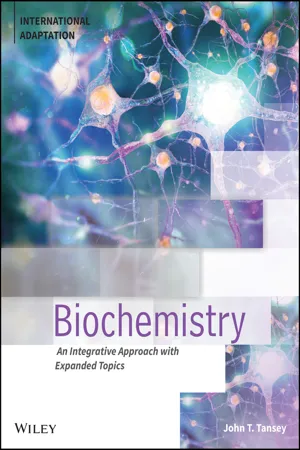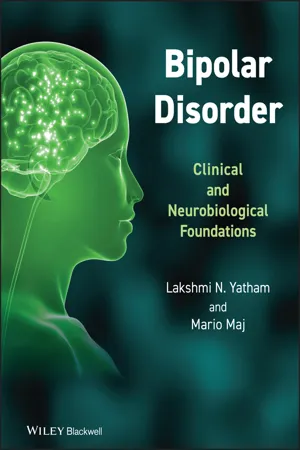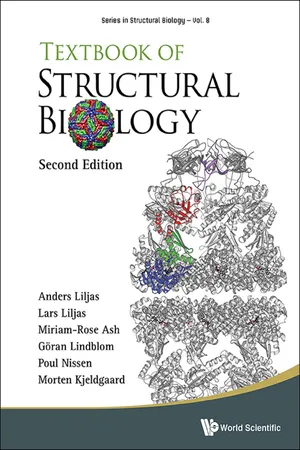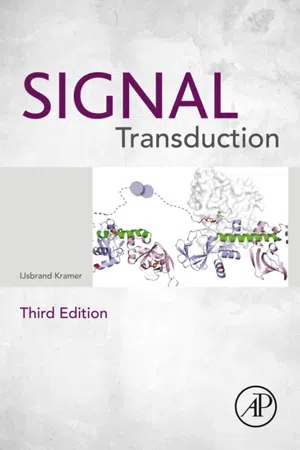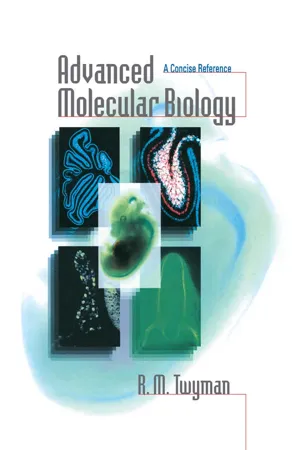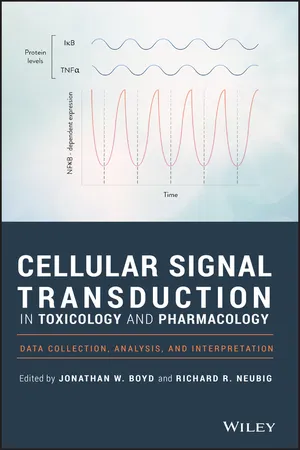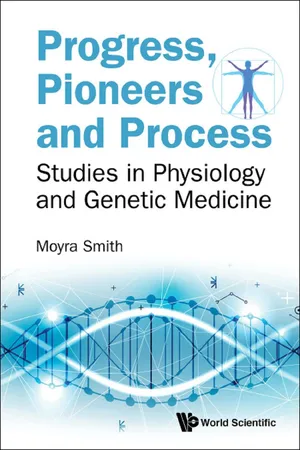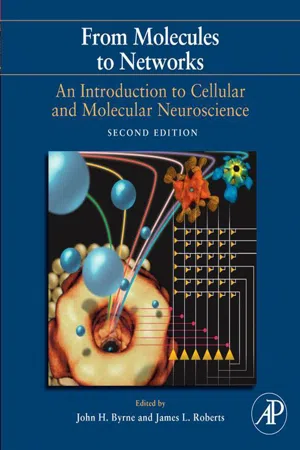Biological Sciences
Signal Transduction Pathways
Signal transduction pathways are a series of molecular events that transmit signals from the cell surface to the nucleus, resulting in a specific cellular response. These pathways often involve the activation of receptors, intracellular signaling molecules, and ultimately the regulation of gene expression or other cellular processes. They play a crucial role in coordinating various cellular activities in response to external stimuli.
Written by Perlego with AI-assistance
Related key terms
Related key terms
1 of 4
Related key terms
1 of 3
10 Key excerpts on "Signal Transduction Pathways"
- Timir Tripathi, Vikash Kumar Dubey, Timir Tripathi, Vikash Kumar Dubey(Authors)
- 2022(Publication Date)
- Academic Press(Publisher)
Cells need to be in constant communication with neighboring cells and the extracellular environment to maintain internal homeostasis, grow, and divide. Signal transduction helps the cells internalize the external cues and carry out effector functions necessary for survival. Signaling controls virtually all the key biological processes of cells, i.e., cell growth, division, differentiation, energy metabolism, migration, and cell death. A signal transduction pathway can regulate one or more of these cellular functions. There are various modes of cell-to-cell communication, depending on the source of the signal received by the cells. Cells can receive messages carried by small molecules, peptides, or proteins secreted by other cells. Cells can also undergo direct physical contact with each other for signaling. They can also receive signals from the extracellular matrix (ECM), where the ECM relays information through mechanical stimuli or ECM-bound molecules. Physical factors, such as heat, light, electrical impulses, and mechanical forces, also activate specific signaling pathways. All these signals activate specific pathways that translate into a change in cell behavior and function. The various modes of signaling and the associated pathways are discussed in the next section.4.1: Cells can proliferate upon induction with long-range signaling by soluble molecules
Estrogens are a group of four C18 steroids derived from cholesterol. 17β-estradiol or estradiol is the predominating estrogen circulating in the blood.17 Granulosa cells of the ovarian follicles secrete the majority of the estradiol, which travels through circulation and act on epithelial cells of mammary glands and uterine endometrium. Estradiol signaling in these cells induces growth and proliferation, resulting in the development of secondary sexual characters.18 Estradiol signaling is also linked to cell differentiation and maintaining cellular homeostasis in the cardiovascular, musculoskeletal, central nervous system (CNS), and immune systems, thus showing a broad spectrum of physiological functions.19 – 21 Estradiol signaling requires the hormone to bind with receptors present on the target cells. Estrogen responsive cells display two classes of receptors for estradiol binding. The classical or genomic estradiol signaling pathway involves the cytoplasmic estrogen receptors (ER) ERα and/or ERβ.22 , 23 They belong to the nuclear hormone receptor (NHR) family. The nonclassical or nongenomic estradiol signaling pathway involves rapid signaling through a G-protein coupled membrane receptor known as G-protein coupled estrogen receptor (GPER)-1.24 Different variants of the ER, particularly ERα, are also found in the cell membrane that mediates membrane-bound receptor signaling pathways. The genomic signaling pathway leads to the binding of the estradiol receptor complex directly to responsive DNA elements (Direct DNA binding) or utilizes other transcription factors to bind to the DNA (Indirect DNA binding).25- eBook - ePub
Biochemistry
An Integrative Approach with Expanded Topics
- John T. Tansey(Author)
- 2022(Publication Date)
- Wiley(Publisher)
This chapter looks beyond regulation of enzymatic activity to examine some other facets of cell signaling, particularly in growth and dif ferentiation of cells and tissues. One of the advantages of specializing tissue function into storage (adipose), movement (muscle), and collected metabolic pathways (liver) is that an organism can have dedicated systems for these dif ferent metabolic roles. A complex organism needs to first generate these tissues and systems, then orchestrate their growth and dif ferentiation, and finally coordinate their response to dif ferent metabolic states. Collectively, all this information is significant not only in terms of basic biochemistry but also in immunology, developmental biology, and the processes involved in diseases such as cancer.21.1.1 Signal transduction follows certain basic principlesSignal transduction is generally accomplished through chemical signals, although some specialized cells can detect and respond to light. For communication to occur, three things need to be in place: a signal (a chemical compound released by other cells somewhere in the organism or by other organisms in the environment), a receptor for the signal, and a means by which the cell can respond (Figure 21.1 ). Signals are often hormones, and receptors are often transmembrane proteins.FIGURE 21.1 Fundamentals of signal transduction. In any signal transduction pathway, the binding of a signaling cell to a receptor initiates a cascade within the cell that ultimately results in alterations to enzyme activity or gene expression. Sometimes the signal is first propagated and amplified through a second messenger.The binding of the signal by the receptor on the extracellular side is specific, and it elicits a conformational change in the receptor that causes a change on the intracellular side of the protein. The change in the conformation typically activates enzymes such as kinases, and it can stimulate protein signaling pathways directly or be amplified by other enzymes and second messenger signaling molecules such as Ca2+ or cyclic AMP (cAMP). Recall that a second messenger - eBook - ePub
Bipolar Disorder
Clinical and Neurobiological Foundations
- Lakshmi N. Yatham, Mario Maj, Lakshmi N. Yatham, Mario Maj(Authors)
- 2011(Publication Date)
- Wiley(Publisher)
Over the past 10 years, studies using animal models, postmortem brain tissue and lymphocytes samples have examined the intracellular Signal Transduction Pathways linked to neurotransmitters to investigate the biological basis of BD. In this chapter, we will review the evidences for abnormalities in Signal Transduction Pathways in BD. We will also discuss how these pathways may be relevant in the treatment of this illness with mood stabilizing medication.Signal Transduction PathwaysSignal Transduction Pathways are uniquely responsible for coordinating the cellular response to information impinging on the cell from multiple sources and time frames [17]. These pathways follow a broadly similar course that can be viewed as a molecular circuit, which can detect, amplify and integrate diverse external signals to generate cellular response such as enzyme activity, stimulation of proliferation or cell death and lastly induced gene expression [17].Abnormalities in these pathways may lead to a functional imbalance in multiple neurotransmitter pathways, which could account for the diverse clinical features found in BD [18]. Most neurotransmitter receptors are coupled to guanine-nucleotide binding proteins (G-protein). These proteins link receptors to specific enzymes that activate second messengers, or alternatively, they link to specific ion channels. Now, the extracellular signals are integrated, amplified and transmitted to specific intracellular enzymes, called effectors, which catalyse the production of an extensive array of cascading second messengers. In turn, these messenger molecules act on various protein kinases [17]. The activation of these kinases is instrumental in regulating diverse intracellular processes, including gene expression, and in relating these to lasting neurobiological changes [17].The number of findings for abnormalities in signal transduction systems in samples obtained directly from patients is growing. Indeed, animal and cell culture studies have demonstrated pharmacological effects of mood stabilizers, especially lithium, suggesting its role in neuroprotection, which range from reducing excitotoxicity through increased glutamate uptake, to regulation of a number of second messenger systems, such as adenylate cyclase (cyclic adenosine monophosphate, cAMP), phosphoinosi-tide (PI), protein kinase C (PKC), protein kinase A (PKA), protein kinase B (AKT) and glycogen synthase kinase-3 (GSK-3) [19]. - eBook - ePub
- Anders Liljas, Lars Liljas;Miriam-Rose Ash;G?ran Lindblom;Poul Nissen;Morten Kjeldgaard(Authors)
- 2016(Publication Date)
- WSPC(Publisher)
14Signal Transduction
Signal transduction is a central topic in all organisms and this is particularly true for multicellular organisms. In principle, all activities need to be regulated. This can be done by smaller signaling molecules or by macromolecules. Several chapters have already touched on different signaling systems. Transcription (Chapter 10 ) is highly regulated and so is the degradation of macromolecules (Chapter 12 ). One main route of communication of external signals to the nucleus is by protein phosphorylation. The immune system (Chapter 17 ) is also an example of complex signaling. The signaling often occurs as a cascade, where a chain of sequential reactions leads to the final effector.14.1Signaling Controls the Cellular Activity from the Outside
Many of the activities in the eukaryotic cell are controlled by factors outside the cell. This is especially true in multicellular organisms, where different kinds of cells in various kinds of tissues need to respond differently to make the whole organism function properly.Outside factors influence the cells through signaling pathways. In most pathways, the factor binds to a receptor molecule in the cell membrane. The receptor molecule transfers the signal (but not the molecule) to the inside of the membrane, where other molecules react to the signal, multiplying the effect, and at the end this leads to the desired activity in the cell. The factor may be a small molecule like epinephrine or odorants, a short peptidelike glucagon, or proteins like growth hormone and the interferons. Some pathways use lipophilic factors that can pass the cell membrane and activate intracellular receptors. The whole process is called signal transduction.There are two main types of signaling pathways:(i) Some signals require immediate changes in the state of the cell, for example, when the cells of our visual system react to photons. In this case, the signal leads to a quick change in the state of the cell that can be sensed by nerve cells and create an impulse to the brain. The signal leads to a change in activity of existing proteins. Signaling pathways of this kind often use G-protein coupled receptors and trimeric G-proteins that can activate various effector molecules. - eBook - ePub
- ljsbrand M. Kramer(Author)
- 2015(Publication Date)
- Academic Press(Publisher)
Chapter 2An Introduction to Signal Transduction
Abstract
Introduction to signal transduction provides an overview of the many mechanisms that cells employ to create a symbolic representation of their environment. It deals with first messengers (ligands) and receptors and how they interact, their basic pharmacology, and their modes of signal transmission into the cell. It deals with transducers, effectors, and second messengers. It provides an overview of allosteric regulation and posttranslational mechanisms including methylation, acetylation, glycosylation, ubiquitinylation, sumoylation, and phosphorylation. It focuses on nucleotide exchange and GTP-binding proteins, and on protein phosphorylation, from bacteria to men, with special attention to phosphate donors and the structure and catalytic mechanisms of protein kinases and phosphatases. The distinctive role of the different signaling mechanisms is presented in the context of the most “Nobel” of signaling pathways, adrenaline-mediated activation of glycogenolysis in striated muscle (adrenoceptors, G-proteins, adenylyl cyclase, protein kinase A, phosphorylase kinase, glycogen phosphorylase). It shows how different pathways can interfere with each other (concept of signaling nodes).Keywords
First; G protein; Kinase; Messenger; Phosphatase; Posttranslational; Protein; Receptor; Second; SignalingCells need ways to create symbolic representations of their (changing) environment
A goal for the future would be to determine the extent of knowledge the cell has of itself and how it utilizes this knowledge in a “thoughtful” manner when challenged. Barbara McClintock. Nobel Prize acceptance lecture, 1983The above quote relates to homeostatic adjustments required of cells, and McClintock refers to the sensing devices that signal adjustments in the number of ribosomal DNA loci, mishaps affecting DNA, or amitotic division. We refer to this as the “signals from within,” such as those that recruit nucleotide repair machinery to the DNA or allow cells to deal with protein folding stress in the rough endoplasmic reticulum. Knowing their inner self is one thing, but cells also need to deal with their environment and this is particularly complex when they are part of an organism. Importantly, the wellbeing of the organism impacts on that of the cells and good lines of communication between the two entities are primordial. Taking this into account we can add a second scientific goal by adjusting the quote of McClintock as follows: - eBook - ePub
Advanced Molecular Biology
A Concise Reference
- Richard Twyman(Author)
- 2018(Publication Date)
- Garland Science(Publisher)
These interact with transmembrane (membrane-spanning) or membrane-associated receptors and cause a change of receptor structure. The interaction may result in signal transport, i.e. the signaling molecule is internalized (either by carriage caused by the conformation change of the receptor, by the creation of a pore, e.g. in the case of ion channels, or by receptor-mediated endocytosis). Alternatively, the conformational change in the receptor may induce enzyme activity inside the cell which mediates downstream effects while the ligand remains on the outside (signal transduction). Physical stimuli may also interact with receptors or may mediate their effects directly. Light stimulates the G-proteins linked to rhodopsin and cone opsin receptors when photons cause a conjugated light-sensitive molecule 11- cis retinal to change to the all-trans conformation. Conversely, the response to heat shock and similar stresses is mediated directly by increases in denatured protein in the cell. Signal transduction involves pathways of sequential enzyme activation and modulation of the levels of small molecules termed second messengers. This allows the amplification of the original signal (direct diffusion and signal transport provide only a linear response). Signal Transduction Pathways can converge and diverge, allowing multiple stimuli to generate similar responses, and individual signals to effect different responses. Further diversity is generated by different responses to the length and intensity of the stimulus, and the cell-specific synthesis of different receptors and signaling components - eBook - ePub
Cellular Signal Transduction in Toxicology and Pharmacology
Data Collection, Analysis, and Interpretation
- Jonathan W. Boyd, Richard R. Neubig, Jonathan W. Boyd, Richard R. Neubig(Authors)
- 2019(Publication Date)
- Wiley(Publisher)
9 Future Research in SignalingJonathan W. Boyd1 Department of Orthopaedics and Department of Physiology and Pharmacology, West Virginia University School of Medicine, Morgantown, WV, USA2 Department of Orthopaedics, West Virginia University School of Medicine, Morgantown, WV, USA3 Department of Oecotrophologie, Fulda University of Applied Sciences, Fulda, Hesse, Germany1, Nicole Prince2, and Marc Birringer3The aim of this book is to inform the reader about the intimate relationship between signal transduction and cellular survival/death, but the overarching goal of all mechanistic toxicology and pharmacology is to better understand both the causes of disease and potential treatments. With this goal in mind, it is important to identify areas of future research that could improve our understanding of cell signaling and serve as a bridge that better connects cellular response with disease states. There are some interesting recent studies that provide unique perspectives on signal transduction, which we hope will provide both insight and inspiration to further enhance our understanding of the integration of cellular signaling networks into tissues, organs, and whole organisms.9.1 Translational Research and a Spatiotemporal Understanding of Signal Transduction
For cellular signal transduction research to reach its potential in toxicology and pharmacology, it is necessary to bridge the gap between early responses and end disease states. Individual cells are preprogrammed with a certain amount of robustness that allows them to respond to many different types of exposures and conditions, but in a eukaryotic organism, they also possess the ability to sense and respond to a multicellular environment. Signaling responses to changes in the localized environment can lead to critical cellular bifurcations, which may result in altered processes or functions for the individual cell. The modified functions of this single cell may impact other local cells, which changes their - eBook - ePub
Progress, Pioneers and Process
Studies in Physiology and Genetic Medicine
- Moyra Smith(Author)
- 2018(Publication Date)
- WSPC(Publisher)
There are protein kinases within the cytoplasm of the cell that are primarily involved with the phosphorylation of the amino acids serine and threonine within the protein. Transfer of phosphate to amino acids activated proteins. Subsequently phosphatases act to remove phosphate from those proteins and to reduce their activity.Activation leads to increased production of second messengers. These include lipid molecules such as phospholipases, diacylglycerol, and phosphatidylinositols. Cyclic Amp represents the first described second messenger. Activated G proteins increase activity of adenyl cyclase that increases synthesis of cyclic AMP. Cyclic Amp activates a specific subunit of protein kinase C. This phosphorylates CREB in the nucleus that can stimulate gene transcription.The phosphorylation signal on receptors may eventually be passed on to major intracellular signaling pathways such as the MAP kinase cascade. Ultimately signal transmitted through the MAP kinase cascade passes to the nucleus and leads to specific gene transcription.7.5Signaling PathwaysIn summary, cellular receptors contain extracellular regions that can be activated by ligand binding. The cellular receptors also contain trans-membrane regions and intracellular regions. Receptor activation can lead to downstream activation of the intracellular G proteins and these in turn interact with different intracellular signaling pathways. These different signaling pathways can also interact with each other. Ultimately these signaling processes lead to regulation of metabolic processes, activity of transporters and ion channels, gene transcription, and cellular processes necessary for homeostasis (Neves et al ., 2002).Examples of key growth factor signaling pathwaysTransforming growth factor beta (TGF beta) signaling receptor binds to it specific ligand, the transforming growth factor. The intracellular region of the activated dimerized TGF beta receptor undergoes phosphorylation. Subsequently this leads to phosphorylation of the molecule SMAD4. Phosphorylated SMAD can enter the nucleus and activate transcription (Massagué and Wotton, 2000). - Alfredo Meneses(Author)
- 2013(Publication Date)
- Elsevier(Publisher)
8Basic Elements of Signal Transduction Pathways Involved in Chemical Neurotransmission
Claudia González-Espinosa and Fabiola Guzmán-Mejía, Pharmacobiology Department, Center for Research and Advanced Studies (Cinvestav), South Campus, Mexico City, MéxicoDistinct process of signal transduction triggered in neurons by receptors to neurotransmitters and neuromodulators have been recognized as responsible for long-term changes on synapse function. Some of those biochemical modifications to the metabolism of information inside neurons are thought related to memory formation and consolidation. Basic notions of signal transduction are, then, necessary for the understanding of current literature and hypothesis on the neurotransmitter systems involved in prolonged alterations to neuronal function. This chapter briefly summarizes some fundamental concepts and elements of the signal transduction systems involved in synaptic chemical transmission.Keywords
Signal transduction; chemical neurotransmission; G-protein-coupled receptors.Introduction
Research on cellular and molecular mechanisms involved in learning and memory constitutes a leading area in neuroscience that started long time ago. Since the mid-twentieth century, researchers have been concerned not only in finding the neurotransmitter systems involved in the transmission of electrical stimuli between nerve cells, but also in determining the long-term molecular changes that lead to long-term modifications to neural activity due to the neurotransmission process. One of the underlying hypothesis of molecular approaches to neurotransmission is that specific characteristics on the neuron-to-neuron communication (such as the intensity, duration, and composition of the signal) induce particular and sometimes irreversible modifications on neuron physiology leading to learning and memory consolidation. Description of the main neurotransmitter systems came together with the discovery of important changes in the postsynaptic terminals after the learning process. Those findings contributed to the late recognition of the importance of signal transduction events on the generation and maintenance of long-term changes on neural function, and allowed researchers to propose that abnormalities on particular signaling cascades could lead to modifications on the learning and memory processes.- eBook - ePub
From Molecules to Networks
An Introduction to Cellular and Molecular Neuroscience
- Ruth Heidelberger, M. Neal Waxham, John H. Byrne, James L. Roberts(Authors)
- 2009(Publication Date)
- Academic Press(Publisher)
Therefore, predictions of behavior that neglect fluctuations may be false. Nevertheless, for many biochemical pathways, continuous models consisting of sets of differential equations (e.g., Eqs. 14.12 – 14.15) will remain essential because of insufficient data to justify a stochastic model. Generally, data used to construct a continuous model relies on large and reproducible changes in pathway fluxes and concentrations following strong stimuli. Because those responses are reproducible, a continuous model may be expected to reliably predict responses to new stimuli of similar strength to those used in model construction. Genes can be Organized into Networks that are Activated by Signaling Pathways Gene regulation is a common end point of biochemical signaling pathways. As discussed in Chapter 13, signaling pathways often activate proteins termed transcription factors (TFs) (Kewley et al., 2004). Activation is often via phosphorylation of critical amino acid residues. Activated TFs regulate the transcription of genes by binding to nearby short segments of DNA. In Chapter 13, these segments were referred to as cis -regulatory elements. Another term is response elements. If these elements activate transcription, they are commonly termed enhancers ; if they repress transcription, they are commonly termed silencers. Many genes are regulated by multiple TFs. Genes coding for TFs can be repressed or activated by TFs, including their own products. Large clusters of genes are often regulated in concert by biochemical signaling pathways that activate specific TFs. For example, activation of MAPK can lead to activation of hundreds of genes and repression of many others (Roberts et al., 2000). Gene networks may be defined as gene clusters in which the expression of some members is regulated by the protein products of other members, or by a common input such as a hormone or neurotransmitter stimulus. The expression of network genes varies in a coordinated manner
Index pages curate the most relevant extracts from our library of academic textbooks. They’ve been created using an in-house natural language model (NLM), each adding context and meaning to key research topics.
Explore more topic indexes
Explore more topic indexes
1 of 6
Explore more topic indexes
1 of 4

